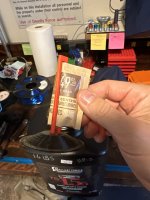I've been using humidity packs in my powder for about 2 years. Was at range the other day, shooting 50 BMG reloads, 2865 fps, SD<10, all good just like usual. Used up that batch, opened a new batch of reloads (marked on the label "RH 49%), velocity fell almost 100 fps average, and the SD was ALL over the place. I'm like WTF, tore them apart when I got home, the charges were all correct. Then I noticed the date of reloading: 7/6/2023. Here's one POSSIBILITY of what happened.
There were 4 humidity packs in the 8# jug of RL50 I used last summer and am still using. If I put them in the new jug when I started the reloading session, out in my garage with 100 degree temperatures, the 49% humidity packs would start releasing moisture to get to the 49% RH. Moreover, if it had not sat/mixed long enough, the powder may have uneven humidity, with granules close to the packs having more moisture until full mixing occurred. Who knows what the distribution of humidity was if it was inadequately mixed by the time it got into the Superspiller hopper.
I had not paid enough attention to what happens to absolute water content when temperature changes at a constant relative humidity. The water content goes up something like 5x or more if you go from 50 degrees to 100 degrees at a constant RH. See: https://brownell.co.uk/datasheets/basics_humidity.pdf
I'm not SURE this was the source of my problem, but I realized the humidity packs could be a HUGE mistake if you have temperature changes in your powder (I store mine in the basement and reload in the garage which varies markedly in temperature throughout the year).
If I want the water content of the powder to remain constant, I have to keep the temperature constant when those packs are in place. In my basement it's almost always 60-70 degrees year round. Humidity packs in the powder are fine down there, but if I take the powder to the garage in summer, the packs are going to immediately (and unevenly) start releasing moisture since the hotter air in the container can contain more moisture at a constant RH. Conversely, if I go out in the garage and it's below freezing, the RH in the container will go up, and the packs will start removing moisture from the powder. So I should always remove the packs prior to reloading, and replace for storage, is what I'm thinking. At least if the ambient reloading temperature is significantly different from where the powder has been stored.
The other thing is I'm going to start recording both the temperature I reloaded at and the RH of the powder (measured by Kestrel drop) at the time of reloading.
Finally, the amount of water in an 8# jug is pretty minuscule, so even large relative changes in water content do not cause big absolute changes. However, all the "experimental" evidence guys have posted seems to suggest it does make a difference.
Interested in any thoughts especially from engineering/physics/chemistry types.
Here is a link that allows you to calculate water content based on temperature and RH: https://www.lenntech.com/calculators/humidity/relative-humidity.htm
There were 4 humidity packs in the 8# jug of RL50 I used last summer and am still using. If I put them in the new jug when I started the reloading session, out in my garage with 100 degree temperatures, the 49% humidity packs would start releasing moisture to get to the 49% RH. Moreover, if it had not sat/mixed long enough, the powder may have uneven humidity, with granules close to the packs having more moisture until full mixing occurred. Who knows what the distribution of humidity was if it was inadequately mixed by the time it got into the Superspiller hopper.
I had not paid enough attention to what happens to absolute water content when temperature changes at a constant relative humidity. The water content goes up something like 5x or more if you go from 50 degrees to 100 degrees at a constant RH. See: https://brownell.co.uk/datasheets/basics_humidity.pdf
I'm not SURE this was the source of my problem, but I realized the humidity packs could be a HUGE mistake if you have temperature changes in your powder (I store mine in the basement and reload in the garage which varies markedly in temperature throughout the year).
If I want the water content of the powder to remain constant, I have to keep the temperature constant when those packs are in place. In my basement it's almost always 60-70 degrees year round. Humidity packs in the powder are fine down there, but if I take the powder to the garage in summer, the packs are going to immediately (and unevenly) start releasing moisture since the hotter air in the container can contain more moisture at a constant RH. Conversely, if I go out in the garage and it's below freezing, the RH in the container will go up, and the packs will start removing moisture from the powder. So I should always remove the packs prior to reloading, and replace for storage, is what I'm thinking. At least if the ambient reloading temperature is significantly different from where the powder has been stored.
The other thing is I'm going to start recording both the temperature I reloaded at and the RH of the powder (measured by Kestrel drop) at the time of reloading.
Finally, the amount of water in an 8# jug is pretty minuscule, so even large relative changes in water content do not cause big absolute changes. However, all the "experimental" evidence guys have posted seems to suggest it does make a difference.
Interested in any thoughts especially from engineering/physics/chemistry types.
Here is a link that allows you to calculate water content based on temperature and RH: https://www.lenntech.com/calculators/humidity/relative-humidity.htm
Last edited:


